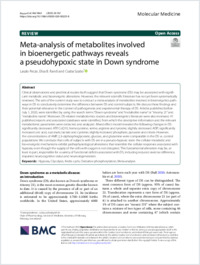Meta-analysis of metabolites involved in bioenergetic pathways reveals a pseudohypoxic state in Down syndrome
- Pecze, László Chair of Pharmacology, Section of Medicine, University of Fribourg, Fribourg, Switzerland
- Randi, Elisa B. Chair of Pharmacology, Section of Medicine, University of Fribourg, Fribourg, Switzerland
- Szabo, Csaba Chair of Pharmacology, Section of Medicine, University of Fribourg, Fribourg, Switzerland
-
09.11.2020
Published in:
- Molecular Medicine. - 2020, vol. 26, no. 1, p. 102
English
Clinical observations and preclinical studies both suggest that Down syndrome (DS) may be associated with significant metabolic and bioenergetic alterations. However, the relevant scientific literature has not yet been systematically reviewed. The aim of the current study was to conduct a meta-analysis of metabolites involved in bioenergetics pathways in DS to conclusively determine the difference between DS and control subjects. We discuss these findings and their potential relevance in the context of pathogenesis and experimental therapy of DS. Articles published before July 1, 2020, were identified by using the search terms “Down syndrome” and “metabolite name” or “trisomy 21” and “metabolite name”. Moreover, DS-related metabolomics studies and bioenergetics literature were also reviewed. 41 published reports and associated databases were identified, from which the descriptive information and the relevant metabolomic parameters were extracted and analyzed. Mixed effect model revealed the following changes in DS: significantly decreased ATP, CoQ10, homocysteine, serine, arginine and tyrosine; slightly decreased ADP; significantly increased uric acid, succinate, lactate and cysteine; slightly increased phosphate, pyruvate and citrate. However, the concentrations of AMP, 2,3- diphosphoglycerate, glucose, and glutamine were comparable in the DS vs. control populations. We conclude that cells of subjects with DS are in a pseudo-hypoxic state: the cellular metabolic and bio-energetic mechanisms exhibit pathophysiological alterations that resemble the cellular responses associated with hypoxia, even though the supply of the cells with oxygen is not disrupted. This fundamental alteration may be, at least in part, responsible for a variety of functional deficits associated with DS, including reduced exercise difference, impaired neurocognitive status and neurodegeneration.
- Faculty
- Faculté des sciences et de médecine
- Department
- Médecine 3ème année, Département de Médecine
- Language
-
- English
- Classification
- Biological sciences
- License
-
License undefined
- Identifiers
-
- RERO DOC 329907
- DOI 10.1186/s10020-020-00225-8
- Persistent URL
- https://folia.unifr.ch/unifr/documents/309167
Statistics
Document views: 148
File downloads:
- pdf: 217
